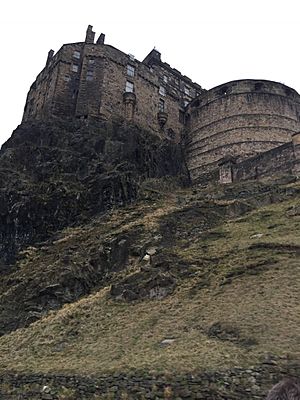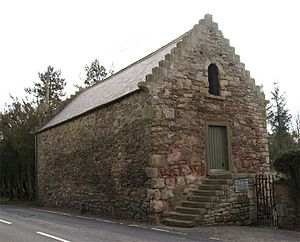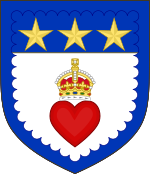George Douglas of Parkhead facts for kids
George Douglas of Parkhead (died 1602) was an important Scottish landowner and businessman. He was involved in mining and even served as the leader of Edinburgh city, known as the Provost. He was also in charge of Edinburgh Castle.
Contents
A Busy Career
George Douglas was the son of George Douglas of Pittendreich. He became known as George Douglas of Parkhead after marrying Marioun Douglas, who owned the land called Parkhead. This area is near the town of Douglas in Lanarkshire. Later in his life, he became the Provost of Edinburgh. He was also the Captain or keeper of Edinburgh Castle.
Rebuilding Edinburgh Castle

After a long battle called the Lang Siege ended in August 1573, George Douglas helped rebuild parts of Edinburgh Castle. He bought materials like lime, sand, slate, and glass to fix the damaged walls. He was in charge of making sure the castle was repaired and strong again.
Many people believe that Parkhead was responsible for building the famous Half-Moon Battery at Edinburgh Castle. This was a strong, wide platform designed to hold many cannons. It helped protect the castle.
Working with Regent Morton
George Douglas became very successful when his brother, James Douglas, 4th Earl of Morton, was the Regent of Scotland. A Regent is someone who rules a country when the king or queen is too young.
When his brother stopped being Regent in 1579, George Douglas made a list of all the valuable items kept in Edinburgh Castle. This included Mary, Queen of Scots's personal jewelry, royal tapestries, clothes, pictures, and even her dolls. He also listed all the cannons and tools.
Douglas was also involved in mining for lead in places like Wanlockhead and Leadhills in Lanarkshire, and in Orkney. In 1581, he lost his mining rights for a while because of a disagreement over a castle.
In 1584, George Douglas and his sons were declared enemies of the king. They lost their lands and property because they were involved in a rebellion called the Raid of Stirling.
Journey to Norway
In October 1589, James VI of Scotland sailed to Norway to meet his future wife, Anna of Denmark. George Douglas of Parkhead was one of the people who went with the King on this important journey. He wrote letters from Norway, sharing news about the King's plans to stay for the winter.
Later Life and Family
George Douglas's wife, Marion Douglas, also helped manage their business. She wrote letters about their lead mines. In 1592, she had to stop their miners from working because of a problem with their mining permits. Later, in 1593, George Douglas and his son James sold some of their mining rights to a rich goldsmith named Thomas Foulis.
A writer named Stephen Atkinson mentioned in 1619 that "George Parkhead" died in a mining accident. He was killed by a landslide at a mine near the Shortcleuch water. It took three days to dig him out. Some people think it was actually his son who died in this accident in 1586, while looking for gold.
George Douglas of Parkhead's will was recorded in Edinburgh in 1602. It mentioned that he had oats stored at a barn in "Auld Foulden".
Family Life
George Douglas and Marion Douglas had several children:
- James Douglas of Parkhead (died 1608): He married Elizabeth Carlyle. Their marriage was difficult. In 1596, James Douglas and his friends killed James Stewart, Earl of Arran, who was an enemy of his father. They said Arran was a rebel. James Douglas was later killed in Edinburgh in 1608 by Captain William Stewart, who was Arran's nephew.
- James and Elizabeth had children, including James Douglas, who married twice.
- George Douglas of Mordington: He married Margaret Dundas. She was the mother of a famous courtier named Robert Kerr.
- George and Margaret had children, including George Douglas, who became an ambassador for King Charles I of England. Their daughter Margaret Douglas married Sir James Lockhart of Lee. Their children included William Lockhart, who was an ambassador, and George Lockhart, a lawyer.
- John Douglas: He became a minister in Crail.
- Catherine Douglas: She married Sir James Douglas of Arniston.
- Margaret Douglas: She married twice.
- Martha Douglas: She married Robert Bruce, who was a minister in Edinburgh.
- Mary Douglas: She married John Carruthers of Holmains.




